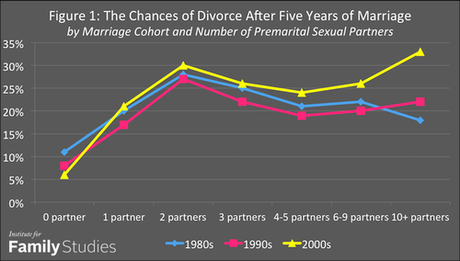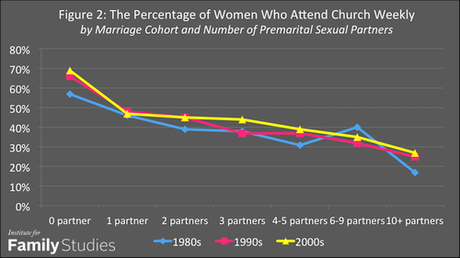Answer: Virgin brides!
Reporting for Family Studies, June 6, 2016, Professor of Family and Consumer Studies at the University of Utah Nicholas H. Wolfinger arrived at that finding by using data from the three most recent waves of the National Survey of Family Growth (NSFG) collected in 2002, 2006-2010, and 2011-2013. For women marrying since the start of the new millennium:
- Women with 10 or more partners were the most likely to divorce, but this only became true in recent years;
- Women with 3-9 partners were less likely to divorce than women with 2 partners; and,
- Women with 0-1 partners were the least likely to divorce.
Wolfinger’s finding confirms earlier research that found that having multiple sex partners prior to marriage could lead to less happy marriages and often increased the odds of divorce. But Wolfinger did uncover news findings, including:
- The proportion of women who get married having had only one sex partner (in most cases, their future husbands) declined from 43% in the 1970s to 21% by the 2000s, to only 5% by the 2010s. The pace of decline quickened after 2000.
- At the other end of the distribution, the number of future wives who had 10 or more pre-martial sex partners increased from 2% in the 1970s to 14% in the 2000s, and then to 18% in the 2010s.
- Unfortunately, the NSFG doesn’t have full data on men’s premarital sexual behavior, and in any event they recall their own marital histories less reliably than do women.
The following chart (Figure 1) depicts the percentage of first marriages ending in divorce within 5 years of wedlock according to the decade the wedding took place and how many sex partners a woman had prior to marriage.

- For all three cohorts, women who married as virgins had the lowest divorce rates by far.
- The percentage of virgin marriages (on the part of the woman, at least) that dissolved within 5 years was 11% in the 1980s, 8% in the 1990s, and 6% in the 2000s.
- The highest 5-year divorce rates of all are associated with marrying in the 2000s and having 10 or more premarital sex partners: 33%.
- Before the 2000s, however, it was women with 2 partners prior to marriage, instead of those with 10 or more pre-marital sex partners, who had the highest divorce rates. Wolfinger’s “best guess” is that two partners may lead to uncertainty, but having a few more apparently leads to greater clarity about the right man to marry. While Wolfinger conncludes that “The odds of divorce are lowest with zero or one premarital partners, but otherwise sowing one’s oats seems compatible with having a lasting marriage,” he warns “But not too many oats” because women who married after 2000 who had had 10 or premarital sex partners had the highest divorce rates of all, of 33%. A lot of partners means a lot of baggage, which makes a stable marriage less tenable.
Religion and Divorce
Wolfinger hypothesized that religion may explain the low divorce rates of people with minimal sexual experience prior to marriage, and the NSFG data support such an interpretation, as seen in Figure 2 below.

- Women who marry as virgins are far more likely than other women to attend church at least once a week.
- More interesting still is that the effect of religion became stronger in recent years — the divorce rate for virgin brides continued to drop for religious women between the 1980s and 2000s.
- In general, people who attend church frequently have lower divorce rates than do non-participants.
- Generally speaking, women who have multiple sex partners are less likely to be regular churchgoers.
Some other explanatory factors for the relationship between number of pre-marital sex partners and divorce are:
- Children: Women who marry with no or just one pre-marital sex partners are unlikely to have had children with another man. Getting married with a child already in tow has a profound negative effect on marital happiness and disproportionately high divorce rates.
- Personal history: People who suffered childhood sexual abuse are more likely to have extensive sexual histories and pre-marital sex. Childhood abuse also increases the odds of a problematic marriage.
- Race: Caucasian and African American women had similar premarital sexual behavior, but Latinas and members of the “Other” population group had notably fewer sex partners and lower divorce rates than either whites or blacks.
- Family history of divorce: People who grew up without both parents had more sex partners and divorced more.
Wolfinger’s most recent book is Soul Mates: Religion, Sex, Children, and Marriage among African Americans and Latinos, coauthored with W. Bradford Wilcox (Oxford University Press, 2016).
Recently, there was a discussion among some commenters on FOTM on the increasing prevalence of brides wearing strapless gowns like this:

I suggest that Professor Wolfinger consider the popularity of strapless wedding gowns as an indicator of pre-marital sex, and as a predictor of divorce.
~Eowyn

